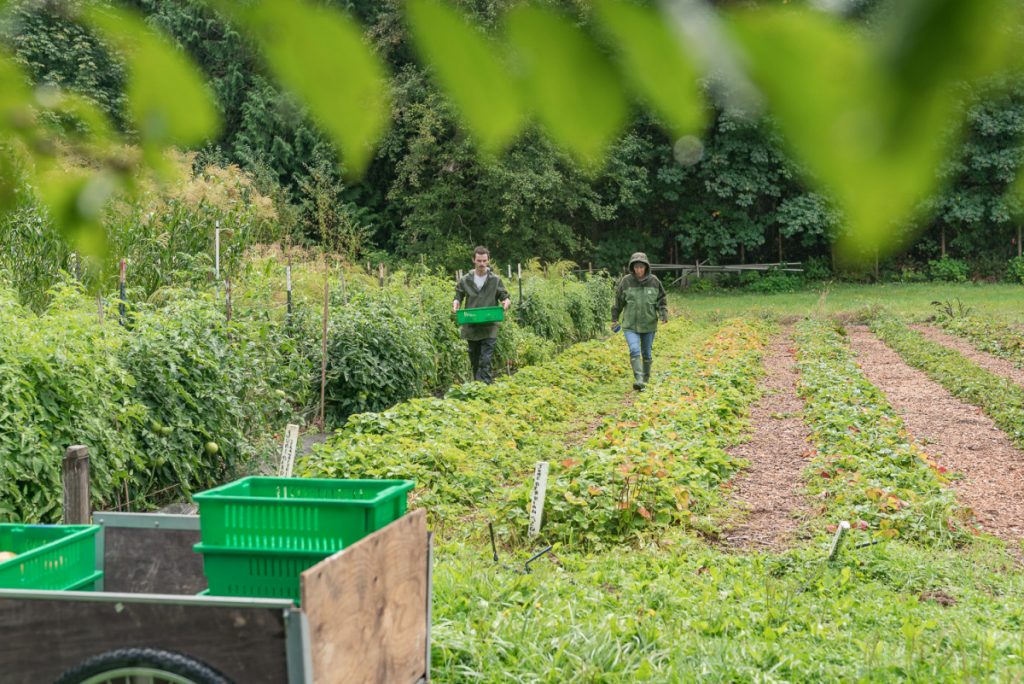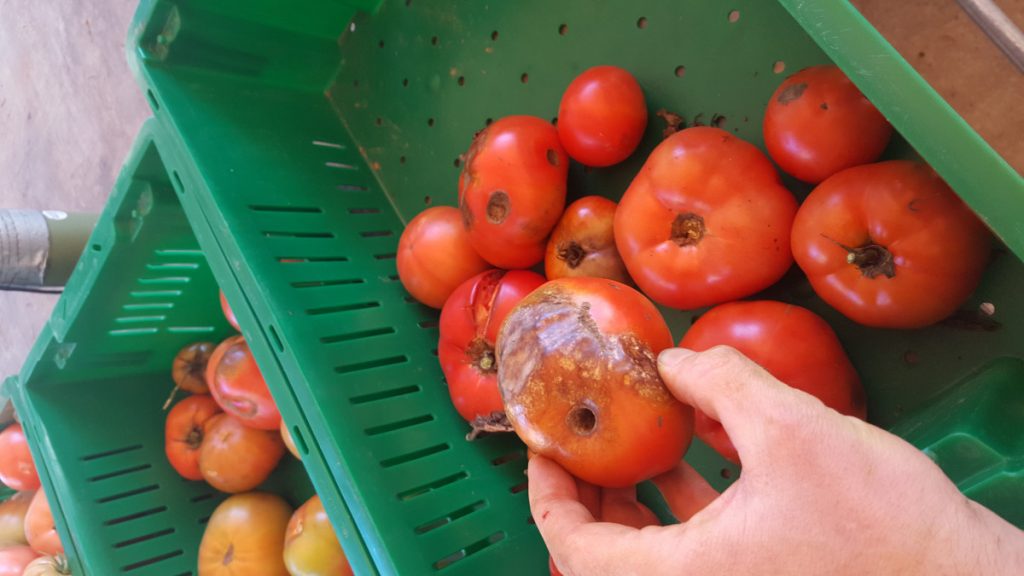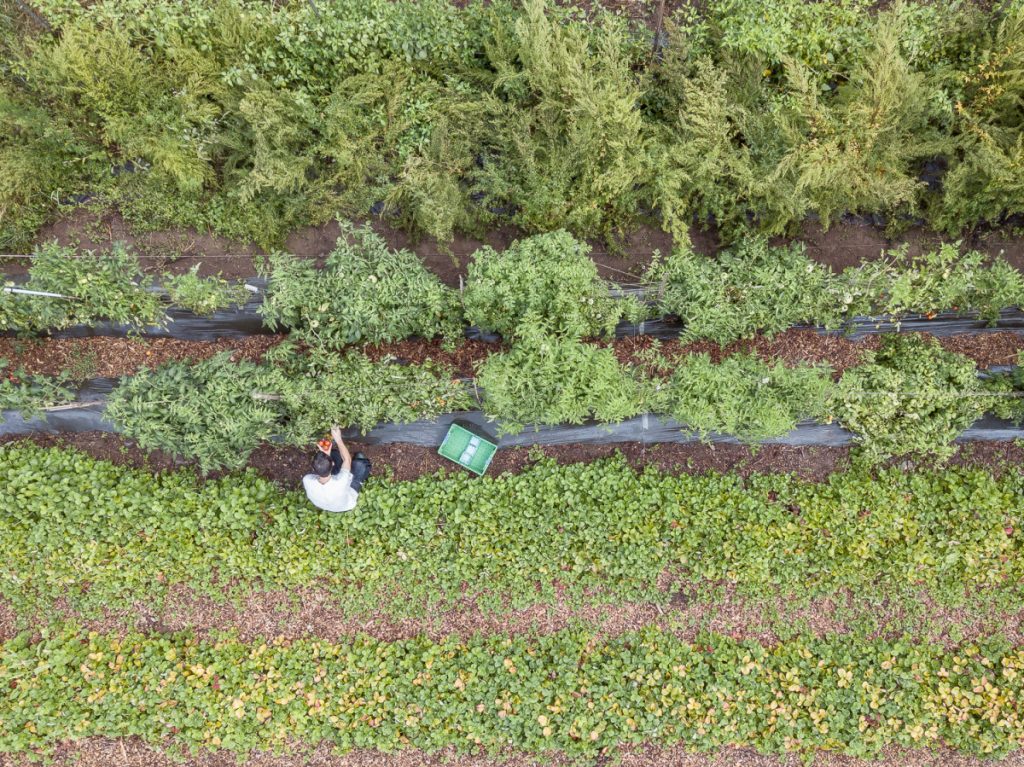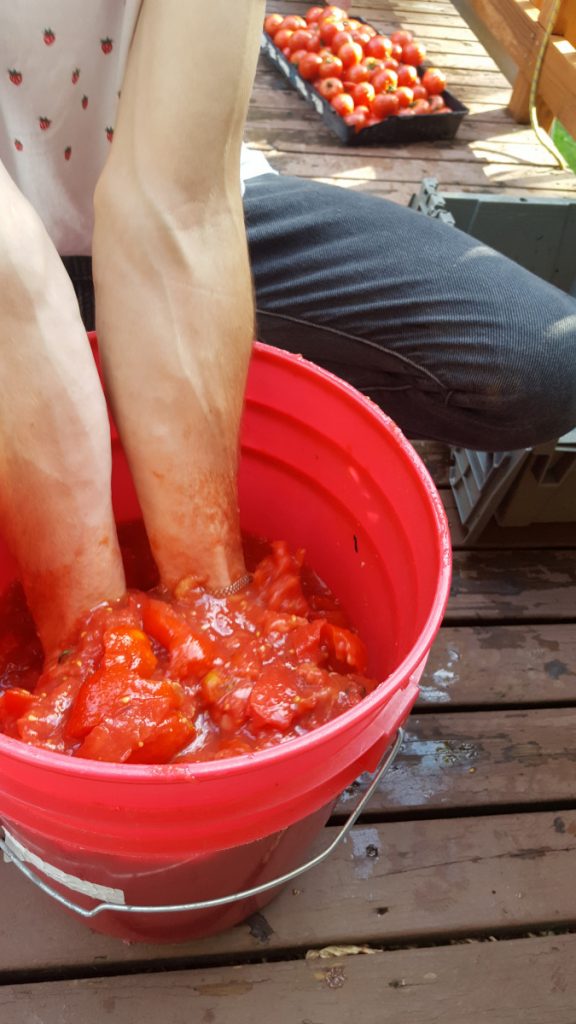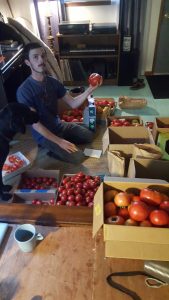This is a beautiful video made by Ryan Richardson of Evergreen State College…..being interviewed is HARD!
2019 NOVIC Tomato Field Trial
Caleb Poppe, The Evergreen State College
Author: Caleb Poppe (page 1 of 6)
The 5th and LAST harvest of the 2019 NOVIC Tomato Trial!! Late blight has all but taken over the field and it is clear which varieties can withstand the onslaught of fungal pathogens (*More information to come*). That all being said, frost and disease have left a mark on the fruit that we so desperately crave, literally. The numbers for marketable tomatoes went wayyy down this week as late blight, and the first frost of the season, made their rounds. For the first time, the unmarketable fruit outweighed the marketable fruit, and the shelf life of these late-season tomatoes has been greatly reduced. It seems the end of the tomato growing season of 2019 is near.
I have begun the hosting of tomato tastings as part of the requirements of the field trial. These tastings include assessments for 3 separate parameters: visual, scent, and taste. As I host these tastings, I walk my peers through what goes into differentiating between the different types of tomatoes. While to some, tomatoes may all taste the same, but when tasted back to back, and focusing on their differences, one can sense the peculiarities of individual varieties. From these tastings I am gathering data on the preferences of my peers with regards to the different varieties that are being grown in the trial. I will compile the info and be able to see if there is a particular variety that is favored over the rest.
The 5th week of harvesting marks the start of the end of the 2019 NOVIC Tomato Field Trial. As most of the plants succumb to late blight, the numbers for harvestable tomatoes have plummeted, and the time for site clean up approaches. Now that I am planning to rip the plants out of the field, and field data collection comes to a close, I will stop posting weekly submissions of information on this wordpress website. Instead I hope to clean up the aesthetics and tie up any loose ends that need to be attended to. I will be posting information that pertains to the data and results of individual varieties, information such as yield weights, disease stress, height and width, flavor preference, etc.
Thank you for following my journey, and reading through my scattered thoughts.
-Caleb Poppe
Each Monday following the weekend is always a surprise. I am never sure what to expect when I walk into the field after a couple days away from the plants; you might expect that conditions change rather slowly where plants are concerned, but changes can be drastic and dramatic. As I walked into the fiel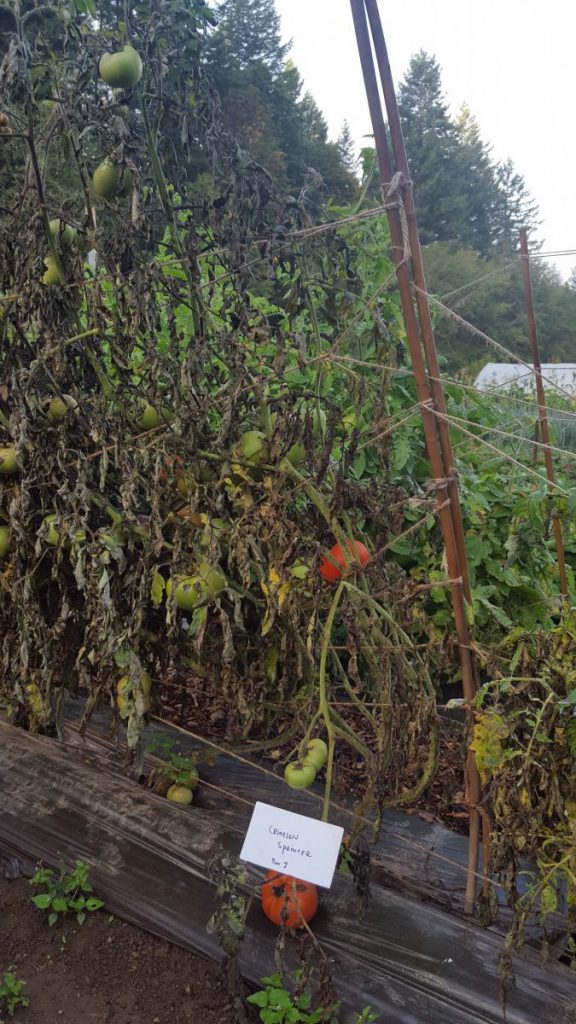 d on this fine, rainy, autumn morning, I was confronted by both life and death. For example, the Crimson Sprinter variety was nothing but a mass of dead leaves and only a few plots to the north stands a clump of green, semi-healthy plots that are only speckled with splotches of late blight cankers. Disease severity is different from variety to variety and covers the full spectrum from healthy to dead. And yet, the dead plants still had a few marketable fruit hanging from the branches.
d on this fine, rainy, autumn morning, I was confronted by both life and death. For example, the Crimson Sprinter variety was nothing but a mass of dead leaves and only a few plots to the north stands a clump of green, semi-healthy plots that are only speckled with splotches of late blight cankers. Disease severity is different from variety to variety and covers the full spectrum from healthy to dead. And yet, the dead plants still had a few marketable fruit hanging from the branches.
This week was harvest week 4. I had mentioned last week how I wouldn’t be surprised if today was to be one of the last harvests of the season but I was pleasantly surprised with the amount of marketable fruit that was ready for me today. There are many varieties that are handling the on-set of Late Blight rather well and I expect to make it through a few more harvests before they all melt away. But then again, everything could shift in a matter of a few moist evenings and cut the season short, and this is another example of why farmers need to be ready for anything.
I walked out of the field with 124lbs of marketable tomatoes, this harvest surpassing the rest. The issue at this point is how to use the exorbitant of tomatoes that I am bringing home. Granted I have to have three tomato tastings over the next month, but that will only leave a small scratch on the surface of my archive. One use for the tomatoes that I have begun experimenting with is a Conserva Cruda di Pomodoro or a raw tomato preserve. Using the tomatoes that have gone soft or succumb to mold, a fermented and cured tomato concentrate is created over a 7-10 day period. I have enjoyed breaking into the world of ferments and I am quite excited to try this version of the classic tomato. In addition to the cruda, I have been eating an abundance of tomatoes and giving many of them away as gifts, only requesting feedback on how the tomato was perceived.
As harvest and data collection continue, I have begun the construction of my scientific poster that I will be presenting in less than a month. Now that I have nearly finished an entire growing season with these tomatoes, I am enjoying the time of putting the whole project into perspective. In the mean time, go out and enjoy a tomato or two and thank a farmer for farming.
As I walked towards the tomato plots this morning, I was rather concerned that I would arrive to find that all of the plants had melted into themselves during the weekend, due to Late Blight. I was pleasantly surprised to see that only 3 plants had truly succumbed to the disease and that the rest of the plot was holding its own against their disease. After a weekend of heavy rain and cold, humid conditions, I would have been surprised to not find that the disease had progressed; but alas, it is only a matter time. After a full plot inspection I determined that roughly 30% of all the plant matter in both plots was affected.
I have to remark on the persistence of a majority of the tomato varieties. I am constantly reminded that the weather has left a lot to be desired, and through dismal weather and imperfect conditions, the tomatoes are producing large quantities of fruit. I harvest roughly 115lbs from both plots today and of that, 95lbs were perfectly marketable. I have tomatoes piling up to the ceiling in my home, waiting for their trial and I am constantly fighting off mold and fruit flies from devouring the supply. I took an inventory of the fruit that I have, and determined that I have harvested marketable fruit from 11 of the 12 varieties and the one that hasn’t yielded any tomatoes has struggled the most of all varieties, through this season. I have one more harvest until my first tasting trial, and I am hoping that the plants hold out for at least one more harvest, if not two. I have plenty of tomatoes to do one tasting trial but I am hoping to do three over the next threes-four weeks. My concern is that I will not be able to have each variety represented at all 3 tastings, but I will make do with I have.
It feels as though the project is coming to a close. The tomato plants are withering away and the tastings are getting nearer and nearer. With this shift comes my preparation for condensing the pages and pages of notes and thoughts that I have gathered over the last 4 months. It feels a bit daunting to try and imagine a nice straight trajectory of the research that I have conducted. I have followed some many different threads of knowledge and science that I am a little intimidated by all of my notes and readings.
I am able to put all of this into perspective by looking at the research from the tomatoes point of view, from its genesis to its senescence. Although I spent hours researching fungal diseases, hours on common pests, hours on tomato life cycles, etc. I can focus on what pertains to the individual variety that I am writing about and forget about the rest. This is my next goal in the project; to put my thoughts into a manageable form that I can easily express to others.
– Harvest week 2 –
Today was a whirl-wind of a day; between heavy-heavy rains, large quantities of ripe fruit, and a brand new disease in the field, today was wild.
I may be a broken record: “the weather was wet all last week”, “last week was a rainy/wet one”, but the weather has truly and officially turned away from summer. Fall is truly in the air, and western Washington has lived up to it’s classic fall-time weather. As I write this, the rain is coming down in sheets and beating down everything in its path, and the forecast shows more rain in the near future. And yet, the tomato plants are pumping out many pounds of ripe and delicious fruit – I harvested nearly 60lbs of fruit today!
The harvests are fairly straight-forward but I will share with you what my process is for picking the fruit and recording the information that should be collected:
- Having all of my harvest supplies gathered, I start by walking though the plots and recording which varieties have ripe fruit, as well as anything new with the plants that may stand out to me and need further investigation.
- Once I have labeled a container with the variety and date that I am to harvest, I will harvest any ripe fruit that I see from the plants.
- Now that I have gone through the process of harvesting the fruit from all of the varieties, I will take notes on the fruit’s physical appearance, the ease of picking, and any other note-worthy information that would be special to that particular variety.
- When all of the harvestable fruit are picked and field notes are taken, I haul them all to my weighing station, separating the fruit into marketable and unmarketable, and weighing them out separately, recording the weights for individual varieties.
- Once this has all been done, and the notes and data have been taken and recorded, I will then store the tomatoes, separated by variety and clearly labeled, for future use, i.e: tasting trials, Brix readings, and personal eating.
—
The dichotomy between healthy plants and sick plants has manifested quite boldly in the fruit of said plants. While a sick plant may produce some ripe fruit, it is apparent that something has inhibited the healthy flow of water and essential nutrients to the fruit. They may appear red from a distance but upon closer inspection, I find blotchy skin that doesn’t get to the full/deep color of a healthy tomato, and a reduction in the overall size of some of the fruit. This is all to say that, although the various diseases haven’t killed the various plants, the fruit have been negatively affected and marketability % is greatly reduced.
To tie everything together a put a nice little bow on this post, I am excited and anxious to report that I believe to have found the first signs of LATE BLIGHT in the field! I am not too surprised by this revelation, in light of the recent weather patterns, but that doesn’t change the fact that it is there. I am not entirely positive in my identification and will be getting a second opinion, but if I am correct, I will know sooner than later. For the successful spread of late blight, humidity and moisture levels must stay relatively high, so if the weather quickly turned hot and dry, the disease may be slowed down. I don’t expect this to be the case. 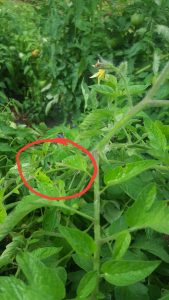
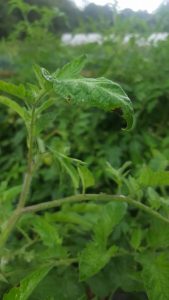
Late blight usually starts on the upper most branches and leaves (they are the first to come in contact with airborne spores) and will then spread fairly rapidly through a plant, especially one that is moist or wet. Not only did I see small marks on the leaves of multiple varieties, I was seeing them on the stems as well, which makes me even more confident of my identification.
Now that I am aware of the disease, I will be checking the afflicted plants daily to see what kind of spread takes place throughout the plots.
Cross your fingers so that the plants survive another 3 weeks, and keep producing fruit through the harvest period and give us some study specimens for the tasting trials!
As always, thanks for reading.
© 2025 2019 NOVIC Tomato Field Trial
The Evergreen State College
Olympia, Washington

